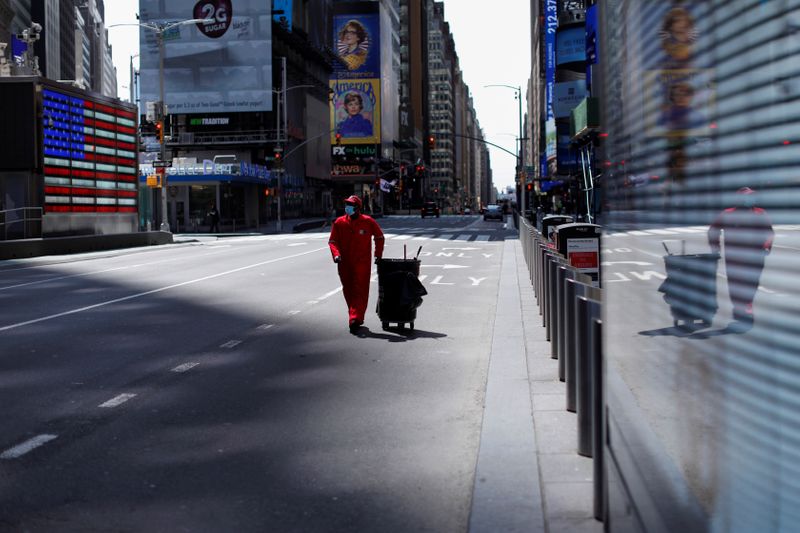BENGALURU (Reuters) – The U.S. economic recession underway, caused by the coronavirus pandemic, will be worse than previously thought, with more economists polled by Reuters over the past week expecting a “U-shaped” recovery rather than any other option.
The novel coronavirus has infected nearly 2.5 million people around the world, killed nearly 170,000 and led to lockdowns in many countries, shutting schools, industries and businesses. The United States has the highest infection numbers and deaths among individual nations.
So far, the U.S. Federal Reserve’s policy of zero interest rates and unlimited asset purchases – which will likely expand its balance sheet to $10 trillion this year, according to the poll – as well as $2.3 trillion of federal government spending, have only softened the blow.
In the latest Reuters poll taken April 15-20, before the price of U.S. crude oil fell below zero per barrel on Monday, just under half of 45 respondents based in the U.S. and Europe who answered an additional question said the U.S. economic recovery would be “U” shaped, as represented on a chart tracking economic expansion or deceleration in percentage terms.
Ten said it would be “V” shaped, seven said it would resemble a tick mark, and five said it would be “W” shaped.
But economists, who have spent the last several weeks slashing forecasts by greater and greater amounts, were more doubtful than ever about the country’s growth outlook, now that the longest expansion on record has abruptly ended.
“We’ve never gone through anything like this before. So, anyone who claims to have real expertise in these sort of issues, I think is not being honest. Right now the weakness is pretty dramatic, the economy is weakening pretty sharply,” said Jim O’Sullivan, chief U.S. macro strategist at TD Securities.
“The bottom line is that there is going to be damage and a lot of firms are not going to survive. So no, we’re not going to get back to where we were – and forget getting above that for quite a while. Ultimately, with time and stimulus, the economy will recover, I’m confident of that. But the real question is how long the recovery takes.”
After more than a month of financial turmoil, including the biggest Wall Street crash since 1929, volatility remains high in global markets.
U.S. gross domestic product is now forecast to have contracted 4.8% in the first quarter and will shrink another 30% this quarter, on a seasonally adjusted annualized basis.
In a poll taken just three weeks ago, the median views were for 2.5% contraction in the first, and 20% contraction in the second quarter.
While the poll predicted a 12% rebound in the third quarter and 9% in the fourth, compared with 10.5% and 5.4% in the previous poll, more than 80% of respondents said the risks to their GDP forecasts in the second half of 2020 were skewed more to the downside.
The median 2020 GDP forecast was downgraded to a drop of 4.1% from a 3% contraction three weeks ago, still more optimistic than the International Monetary Fund’s recent prediction for a 5.9% contraction.
For this year, the median worst-case scenario in the Reuters poll was contraction of 10% compared to a decline of 7.3% previously. The economy is now set for a 3.8% rebound in 2021, compared with 3.2% three weeks ago, the poll showed.
Still, economists said the outlook could be far worse and prolonged, depending on the pandemic’s course.
“Our central expectation is for a rebound in the second half of the year; however, that is riddled with uncertainty and downside risks,” said Kevin Loane, senior economist at London-based Fathom Consulting.
“Among these are the risks that: lockdowns are extended longer than currently envisaged, there is a second wave of COVID-19 cases, temporary job losses are made permanent resulting in labor market friction, businesses fail resulting in wasted capital, or businesses and households remain fearful even without official lockdowns and opt not to spend or hire.”
Graphic – Reuters poll graphic on the U.S. economic outlook: https://fingfx.thomsonreuters.com/gfx/polling/oakvekeyvrd/U.S.%20GDP%20forecast.PNG
With businesses shut, 22 million Americans have filed for unemployment benefits over the past month. The jobless rate was forecast to soar to 13.7% in the current quarter, coming down to 11% in the third quarter and 8.5% in the fourth.
In the meantime, the Fed’s balance sheet rose to a record $6.42 trillion last week, a little under one-third the size of U.S. GDP before the crisis struck. That jumped from just $4.29 trillion in the first week of March.
It is expected to grow another $3.5 trillion to $10 trillion by the end of this year.
Over the course of its response to the last global financial crisis that began more than a decade ago, the Fed’s balance sheet expanded by a total of nearly $3.6 trillion to peak around $4.5 trillion.
Graphic – U.S. Federal Reserve balance sheet size: https://fingfx.thomsonreuters.com/gfx/polling/jznpnrllplm/Balance%20sheet.PNG
Twenty-three of 36 economists said the Fed was not done yet. They said it may resort to buying exchange-traded equity funds as well as non-government mortgage securities and implementing some form of yield curve control, as the Bank of Japan has been doing for many years.
(Additional reporting and analysis by Hari Kishan; Polling by Sujith Pai; Editing by Ross Finley and Bernadette Baum)

















